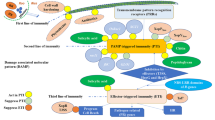Abstract
A new species, Globisporangium oryzicola, was isolated from directly seeded rice seedlings, and from soils of paddy fields and an uncultivated field. Despite their different origins, five of the seven isolates studied caused poor seedling establishment of rice in a laboratory inoculation experiment. The species is characterized by oogonia with smooth-walled or sometimes one projection, with one to two antheridia, and aplerotic oospores. Hyphal swellings were rarely observed. Phylogenetic analyses based on the internal transcribed spacer region of the ribosomal RNA gene and mitochondrial cytochrome c oxidase subunit 1 and 2 genes confirmed that the species differed from other Globisporangium species. This novel species is described and illustrated in detail.





Similar content being viewed by others
References
Bala K, Robideau GP, Lévesque A, de Cock AWAM, Abad ZG, Lodhi AM, Shahzad S, Ghaffar A, Coffey MD (2010) Phytopythium Abad, de Cock, Bala, Robideau, Lodhi and Lévesque, gen. nov. and Phytopythium sindhum Lodhi, Shahzad & Lévesque, sp. nov. Persoonia 24:136–137
Edson HA (1915) Rheosporangium aphanidermatum, a new genus and species of fungus parasitic on sugar beets and radishes. J Agric Res 4:279–292
Ellis ML, Paul PA, Dorrance AE, Broders KD (2012) Two new species of Pythium, P. schmitthenneri and P. selbyi pathogens of corn and soybean in Ohio. Mycologia 104:477–487. doi:10.3852/11-162
Fischer A (1892) Phycomyctes. Rabenhorst, Kryptogamenflora 1:505
Garzón CD, Yánez JM, Moorman GW (2007) Pythium cryptoirregulare, a new species within the P. irregulare complex. Mycologia 99:291–301. doi:10.3852/mycologia.99.2.291
Hoshikawa K (1989) The growing rice plant: an anatomical monograph. Nobunkyo, Tokyo, pp 1–310
Kumar S, Stecher G, Tamura K (2016) MEGA7: molecular evolutionary genetics analysis version 7.0 for bigger datasets. Mol Biol Evol 33:1870–1874. doi:10.1093/molbev/msw054
Lévesque CA, de Cock AWAM (2004) Molecular phylogeny and taxonomy of the genus Pythium. Mycol Res 108:1363–1383. doi:10.1017/S0953756204001431
Martin FN (2000) Phylogenetic relationships among some Pythium species inferred from sequence analysis of the mitochondrially encoded cytochrome oxidase II gene. Mycologia 95:269–284. doi:10.2307/3761428
Miller PM (1955) V-8 juice agar as a general purpose medium for fungi and bacteria. Phytopathology 45:461–462
Möller EM, Bahnweg G, Sandermann H, Geiger HH (1992) A simple and efficient protocol for isolation of high molecular weight DNA from Filamentous fungi, fruit bodies, and infected plant tissues. Nucleic Acids Res 20:6115–6116. doi:10.1093/nar/20.22.6115
Morita Y, Tojo M (2007) Modifications of PARP medium using fluazinam, miconazole, and nystatin for detection of Pythium spp. in soil. Plant Dis 91:1591–1599. doi:10.1094/PDIS-91-12-1591
Pringsheim N (1858) Beiträge zur Morphology and Systematik der Algen. 2. Die Saprolegníeen. Jb Wíss Bot 1:284–306
Robideau GP, De Cock AWAM, Coffey MD, Voglmayr H, Brouwer H, Bala K, Chitty DW, Desaulniers N, Eggertson QA, Gachon CMM, Hu CH, Kupper FC, Rintoul TL, Sarhan E, Verstappen ECP, Zhang Y, Bonants PJM, Ristaino JB, Lévesque CA (2011) DNA barcoding of oomycetes with cytochrome c oxidase subunit I and internal transcribed spacer. Mol Ecol Resour 11:1002–1011. doi:10.1111/j.1755-0998.2011.03041.x
Schröter J (1893) Pythiaceae. Engler Prantl Nat Pfl Fam 1:104–105
Toda T, Iwase A, Fuji S, Furuya H (2015) Widespread occurrence of Pythium arrhenomanes pathogenic to rice seedlings around Japanese rice fields. Plant Dis 99:1823–1831. doi:10.1094/PDIS-01-15-0124-RE
Uzuhashi S, Tojo M, Kobayashi S, Tokura K, Kakishima M (2009) Pythium apinafurcum sp. nov.: its morphology, molecular phylogeny, and infectivity for plants. Mycoscience 50:281–290. doi:10.1007/s10267-009-0486-0
Uzuhashi S, Tojo M, Kakishima M (2010) Phylogeny of the genus Pythium and description of new genera. Mycoscience 51:337–365. doi:10.1007/s10267-010-0046-7
Uzuhashi S, Okada G, Ohkuma M (2015) Four new Pythium species from aquatic environments in Japan. Anton Leeuw J Microb 107:375–391. doi:10.1007/s10482-014-0336-8
Van Buyten E, Höfte M (2013) Pythium species from rice roots differ in virulence, host colonization and nutritional profile. BMC Plant Biol 13:203. doi:10.1186/1471-2229-13-203
van der Plaats-Niterink AJ (1981) Monograph of the genus Pythium. Stud Mycol 21:1–242
White TJ, Bruns T, Lee SB, Taylor J (1990) Amplification and direct sequencing of fungal ribosomal RNA genes for phylogenetics. In: Innis MA, Gelfand DH, Sninsky JJ, White T (eds) PCR protocols: a guide to methods and applications. Academic Press, San Diego, pp 315–322
Author information
Authors and Affiliations
Corresponding author
Rights and permissions
About this article
Cite this article
Uzuhashi, S., Hata, K., Matsuura, S. et al. Globisporangium oryzicola sp. nov., causing poor seedling establishment of directly seeded rice. Antonie van Leeuwenhoek 110, 543–552 (2017). https://doi.org/10.1007/s10482-016-0822-2
Received:
Accepted:
Published:
Issue Date:
DOI: https://doi.org/10.1007/s10482-016-0822-2




